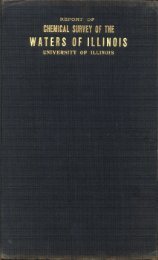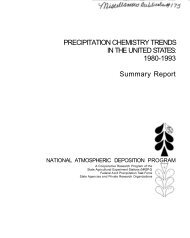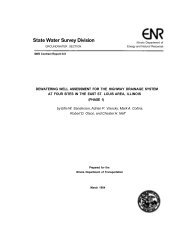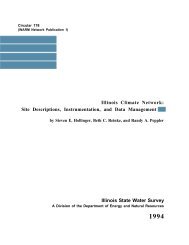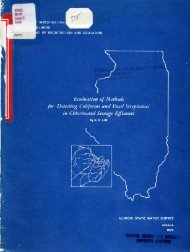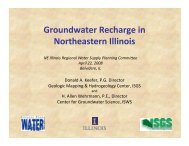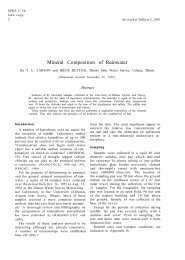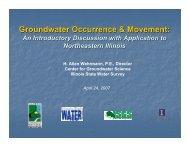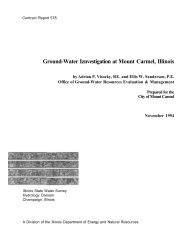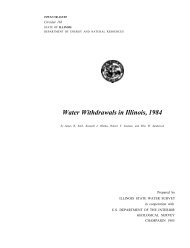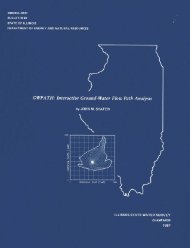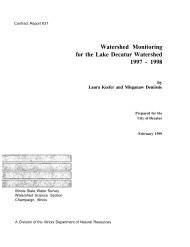Ground-water development in East St. Louis area, Illinois. Urbana, IL ...
Ground-water development in East St. Louis area, Illinois. Urbana, IL ...
Ground-water development in East St. Louis area, Illinois. Urbana, IL ...
You also want an ePaper? Increase the reach of your titles
YUMPU automatically turns print PDFs into web optimized ePapers that Google loves.
Figure 62. Areas of diversion <strong>in</strong> November 1961 Figure 63. Areas of diversion <strong>in</strong> December 1956<br />
Areas of diversion of pump<strong>in</strong>g centers <strong>in</strong> November<br />
1961 are shown <strong>in</strong> figure 62. The boundaries of <strong>area</strong>s of<br />
diversion delimit <strong>area</strong>s with<strong>in</strong> which the general movement<br />
of ground <strong>water</strong> is toward production wells. The<br />
<strong>area</strong> (59 sq mi) north and east of Granite City and south<br />
of Wood River and a larger <strong>area</strong> south of Prairie Du<br />
Pont Creek through Dupo and south along the Mississippi<br />
River were outside <strong>area</strong>s of diversion. As shown <strong>in</strong><br />
figure 63, the <strong>area</strong> north of Granite City outside <strong>area</strong>s<br />
of diversion was much smaller, cover<strong>in</strong>g about 30 sq<br />
mi, <strong>in</strong> December 1956. Pumpage <strong>in</strong> the Granite City <strong>area</strong><br />
was 30.1 mgd <strong>in</strong> 1956 and 8.8 mgd <strong>in</strong> 1961.<br />
Most of the coefficient of transmissibility of the valley<br />
fill deposits can be attributed to the coarse alluvial<br />
and valley-tra<strong>in</strong> sand and gravel encountered <strong>in</strong> the<br />
lower part of the valley fill. The thickness of the medium<br />
sand and coarser alluvial and valley-tra<strong>in</strong> deposits was<br />
determ<strong>in</strong>ed from logs of wells and is shown <strong>in</strong> figure 64.<br />
The thickness of the coarse alluvial and valley-tra<strong>in</strong><br />
sand and gravel exceeds 60 feet <strong>in</strong> an <strong>area</strong> south of Alton<br />
along the Mississippi River, <strong>in</strong> an <strong>area</strong> near Wood<br />
River, <strong>in</strong> places along the Cha<strong>in</strong> of Rocks Canal, <strong>in</strong> a<br />
strip 1/2 mile wide and about 3 miles long through National<br />
City, <strong>in</strong> the Monsanto and Dupo <strong>area</strong>s, and <strong>in</strong> a<br />
strip about 1 mile wide and 4 miles long near Fairmont<br />
City. Thicknesses average 40 feet over a large part of the<br />
<strong>East</strong> <strong>St</strong>. <strong>Louis</strong> <strong>area</strong>. The coarser deposits dim<strong>in</strong>ish <strong>in</strong><br />
thickness near the bluff, west of the Cha<strong>in</strong> of Rocks<br />
Canal, and <strong>in</strong> places along the Mississippi River.<br />
The available drawdown to the top of the medium<br />
sand and coarser deposits was estimated by compar<strong>in</strong>g<br />
elevations of the top of the medium sand and coarser deposits<br />
with elevations of the piezometric surface map for<br />
June 1962 (figure 54). As shown <strong>in</strong> figure 64, available<br />
drawdown is greatest <strong>in</strong> undeveloped <strong>area</strong>s, exceed<strong>in</strong>g<br />
80 feet <strong>in</strong> the vic<strong>in</strong>ity of Long Lake and <strong>in</strong> an <strong>area</strong> south<br />
of Horseshoe Lake. In a large part of the <strong>area</strong> available<br />
drawdown exceeds 60 feet. Average available drawdown<br />
with<strong>in</strong> pump<strong>in</strong>g centers was estimated to be 40 feet<br />
<strong>in</strong> the Alton <strong>area</strong>, 20 feet <strong>in</strong> the Wood River <strong>area</strong>, 35 feet<br />
57



